
There are diverse and often controversial opinions regarding the origins of the Sindhi language. Some scholars maintain that Sindhi is rooted in the Dravidian family, while others assert that it belongs to the Indo-Aryan group of languages. Presently, Sindhi is classified as part of the Indo-Aryan family, but there is an abundance of words in Sindhi with roots in proto-Dravidian and Dravidian languages, many of which persist with only minor phonetic changes. Based on historical evidence and the prevalence of these proto-Dravidian and Dravidian elements in Sindhi, it could be argued that Sindhi was originally Dravidian. However, due to the influence of other languages, particularly from the Vedic Era onward, Sindhi has come to be recognised as an Indo-Aryan language. A thorough comparative and analytic study, focusing on the similarities between Proto-Dravidian, Dravidian languages, and Sindhi, is necessary for deeper understanding.
Until historical and linguistic evidence definitively proves that Sindhi is Dravidian, it cannot be excluded from the Indo-Aryan group. However, a detailed study of Dravidian languages like Tamil, Telugu, Gondi, and Brahui reveals striking linguistic, phonetic, and grammatical similarities, along with a significant shared vocabulary with Sindhi. This suggests that Sindhi may have originally been Dravidian. Many Dravidian words, either unchanged or with slight phonetic variations, are still present in Sindhi today.
In conducting a comparative analysis of Sindhi and other Dravidian languages, we must also address the question of when and how the Indus Valley came to be named Sindh. Historical evidence suggests that the term "Sindhi" referred to those living in the region and speaking the Sindhi language, but the Dravidian languages spoken in the Indus Valley should not be dismissed or overlooked. While some historians attribute a religious significance to the name "Sindh," others argue that the region was named after the River Indus.
Supporting this view are words from Proto-Dravidian and Dravidian languages that hold the same or similar meanings to words still prevalent in Sindhi, as referenced in Kirishnamurti’s and Sanford Steever’s books on the Dravidian languages

According to my recent research, however, the name Sindh predates both the Vedic and Indus Valley civilisations, and has a different origin. It is believed that in the Proto-Dravidian period, the Indus Valley was known as "Cintu" (perhaps an early form of "Sindhu"). Bhandariraju Krishnamurti, in his book The Dravidian Languages (2003, p. 108), mentions that Cintu means "date palm tree," and it may have referred to a region or valley abundant with date palms. During the Dravidian period of the Indus Valley civilisation, there could have been a phonetic shift, with "Cintu" evolving into "Sindi," "Hindi," and "Indi." Terminologically, this suggests that the name of the region may have been connected to date palms rather than the Indus River.
There is also evidence suggesting that the term "Indi" was in use for Sindh during the Indus Valley civilisation, prior to the arrival of the Greeks. Additionally, it is believed that during the Proto-Dravidian period, Gypsies who migrated to Europe referred to themselves as Sinti and Roma. The word "Sinti" might be derived from the proto-Dravidian term Cintu. Even today, Gypsies continue to sing, "We are Sintis."
Regarding date palm trees, it is plausible that date palms were abundant in the Indus Valley during the Proto-Dravidian and Dravidian periods. It is also highly likely that the geography of the Indus River and the ocean during these periods was different from what it is today. At that time, the Indus Valley covered a vast region that may have supported more date palm trees. The areas of present-day Baluchistan, such as Kalat, Karkh, Zeedi, Khuzdar, Charu Machhi, Kinjhar Mari, Ari Pir, Lahoot Lamkan, and in Sindh, regions like Rohri, Khairpur Mer’s, Kai, Naig, and Jhampir, are all known for date palm trees. The words “Sindi,” “Hindi,” and “Indi” in southern Dravidian languages like Gondi are recorded by Kirishnamurti on page 168 of his book, with similar terms found in other Dravidian languages: in Kuvi as “Sindi,” in Parji as “Sindi,” in Gadaba as “Sindi,” and in Telugu as “Idu.”
Supporting this claim are words from Proto-Dravidian and Dravidian languages that hold the same or similar meanings to words still prevalent in Sindhi, as referenced in Kirishnamurti’s and Sanford Steever’s books on the Dravidian languages. These words are cited here along with page numbers. For example, the Proto-Dravidian word “Ka-Wati,” which in Sindhi is “Kanwaati,” appears on page 9. Kanwaati can be described as a pole (wooden) carried on the shoulders, with containers fastened to both ends with rope, resembling the load bearer symbol in the Indus script. On page 190, “Viri” means space or conflict; on page 2, “Vairu” means enmity, and “Vairi” means enemy. On page 9, “Katti” (Kaati) means knife, and on page 46, “Nir” (Niru) means tears or water (B.K. Murti). On page 29, “Ase” means desire (Sanford Steever). In Asko Parpola’s book Roots of Hinduism, on page 383, “Kana” or “Kano” means blind in one eye. All these words with the same meanings are still prevalent in Sindhi today.

Additionally, words from various Dravidian languages carry similar meanings in Sindhi. For instance, Tamil has “Viri” (space) (Murti, p. 17); Kannada has “Piriti” (love) (Steever, p. 132); “Kari” (black) (Steever, p. 137); and “Amma” (mother) (Steever, p. 148). Telugu also shares “Amma” (mother) (Steever, p. 148) and “Katti” (knife) (Steever, p. 239), while “Buba” (father) (Steever, p. 265) and “Katti-tu” (with knife) (Steever, p. 236) are similarly used. Gondi’s “Yayal” (mother) corresponds to the Sindhi “Aayal” with slight phonetic variation (Steever, p. 265). Other words like “Kunj” (pick) (Steever, p. 26) and “likhah” (write) (Steever, p. 292) also show minor phonetic changes. In Kolami, “Kako” (uncle, father’s brother) (Steever, p. 308) matches “Kako” in Sindhi, while “Neku” (headman) corresponds to Sindhi neku or nekumard (p. 308). Similarly, “Ba” (Baba, Father) in Sindhi appears in Steever’s text (p. 308). In Malto, “Kur Kur” (calling dog) (Parpola, p. 283) and “Viri” (space) (Murti, p. 190) have parallels, and in Brahui, “Aaee” (lum, mother) (Shakir Brahui, p. 235) correlates with Sindhi. “Salim” (brother of wife) in Brahui becomes “Salo” in Sindhi with slight phonetic change.
These examples include nouns, pronouns, verbs, and adjectives. The Proto-Dravidian word “Kana,” the Tamil word “Kan,” and the Brahui word “Khan” all mean eye, and they are present in Sindhi in the form of “Kano,” which means one-eyed. Besides this, there are numerous other words that are part of the Sindhi lexicon, albeit with some phonetic changes. Brahui, which is considered a Dravidian language, shares many features with Sindhi, including aspirates like “lh” (Steever, p. 393), along with aspirates such as “jh,” “th,” and “kh.” For example, in Brahui, “Jhal” means hill torrent, “Jhul” refers to cloth for riding on the back of an animal, “Jhalawan” means southern, “Mailath” means sheep, “Halth” means to take, “Hilath” means fever, “Malath” means son, “Khalat” means hit or beat, “Khal” means stone, and “Khan” means eye.
Sindhi and proto-Dravidian languages, as well as other Dravidian languages, exhibit numerous grammatical similarities. These include similarities in vowels, consonants, suffixes, parts of speech, and verb-to-noun and noun-to-verb transformations. Linguistically and grammatically, Sindhi and Dravidian languages are closely aligned. This resemblance between Sindhi and Proto-Dravidian/Dravidian languages suggests that the roots of the Sindhi language lie in the Dravidian family. Over time, due to the influence of Aryan, Persian, Arabic, and other Western languages, Sindhi has been classified within the Indo-Aryan group of languages.

